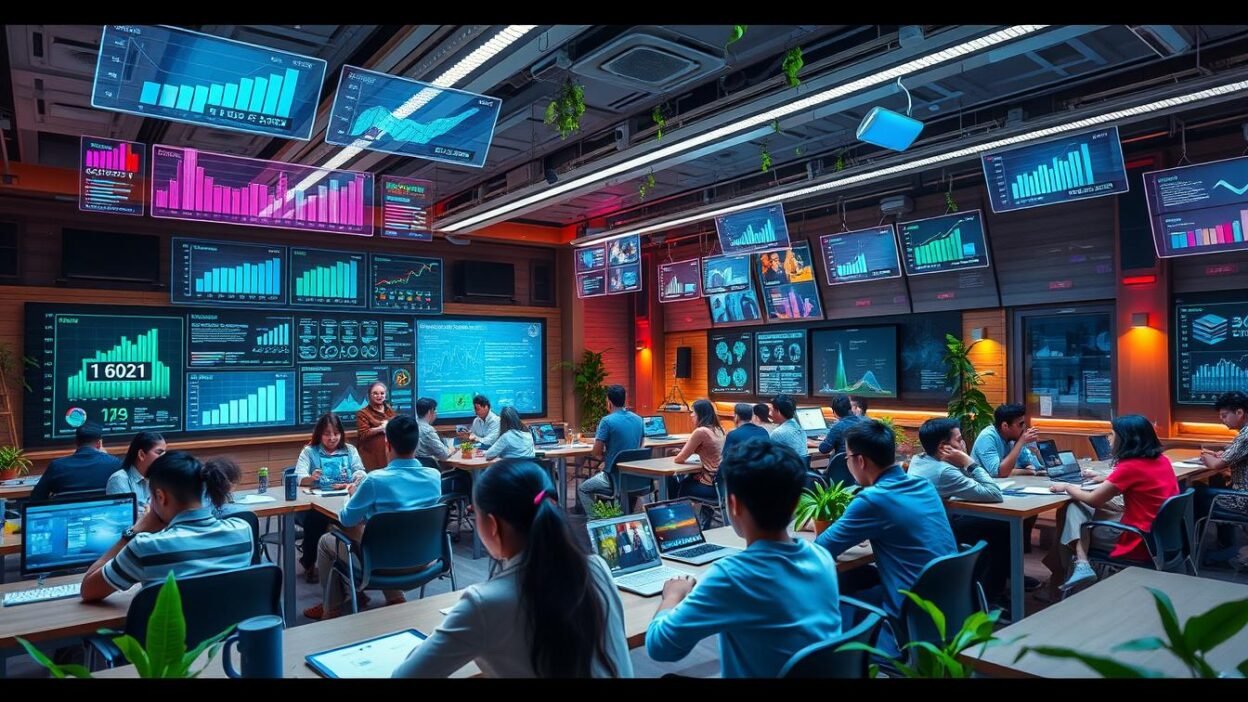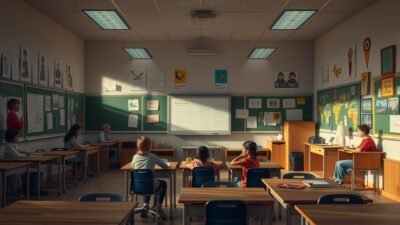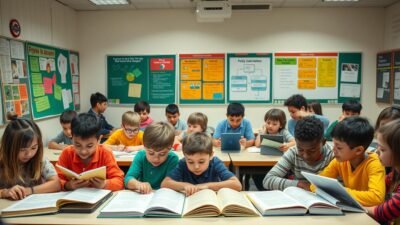How do schools measure student success today? Old ways often focus only on grades. But, modern education looks at more than just scores. It sees the value in creativity and being adaptable.
Teachers around the world, like those in the Baldwin Union Free School District, are changing how they assess students. They now use methods that show how well students can handle real-life challenges. Todd Finley’s research shows that evaluations need to keep up with society’s changes.
Old methods focus on memorizing facts and following strict rules. But today’s classrooms need to teach teamwork, problem-solving, and how to use technology. It’s a tough job to make sure students learn both well and grow as people.
By using technology and listening to everyone involved, teachers can create better learning plans. This article looks at new ways to measure success that focus on skills and include everyone.
Preparing for the UGC NET exam can be a daunting task, but with the right resources, candidates can navigate the process effectively. Websites like MyJRF provide a comprehensive platform for aspiring educators, offering specialized guidance for UGC NET Paper 2 preparation and essential tips for acing UGC NET Paper 1. Additionally, understanding the revised syllabus provided by UGC is crucial for a targeted study approach. For official announcements and updates, candidates should regularly visit the UGC NET NTA portal, while the UGC’s job section and the main UGC website are invaluable for post-exam opportunities and academic resources. With these tools, candidates can maximize their preparation and set themselves up for success. Preparing for Paper 1 and UGC NET Paper 2 Education requires a strategic approach with quality resources. UGC NET Education aspirants can access structured video lectures that cover essential concepts comprehensively. For an in-depth understanding, check out teaching aptitude videos and research aptitude guidance to strengthen your foundation. Additionally, higher education system topics and communication skills preparation are crucial for scoring high. Explore logical reasoning tutorials and mathematical reasoning lectures for better problem-solving skills. Enhance your exam strategy with people, development & environment lessons and ICT in education modules. For previous year papers and practice sessions, explore mock test videos and exam strategy tips. Stay ahead in your preparation with teaching methodology insights and subscribe to Educators Plus for expert guidance.
Key Takeaways
- Modern curriculum evaluation moves beyond grades to assess soft skills like critical thinking and adaptability.
- Case studies from institutions like the Baldwin Union Free School District showcase practical applications of innovative assessments.
- Technology-driven tools enable continuous evaluation, giving real-time insights into student progress.
- Stakeholder collaboration—teachers, policymakers, and industry experts—is vital for creating relevant curricula.
- Global research, including Todd Finley’s work, supports shifting evaluation toward lifelong learning outcomes.
Understanding the Need for Innovative Curriculum Evaluation
Traditional ways of checking how well students learn focus too much on memorizing facts. They don’t look at the bigger picture of learning. Today, we need tests that show if students can apply what they’ve learned in real-life situations. This means looking at more than just how well they can recall information.
The Limitations of Traditional Evaluation Methods
Today’s methods have big problems:
- Narrow focus on grades: Standard tests often just give a number, ignoring creativity and solving problems.
- Rigid frameworks: The same old curriculum doesn’t fit all students or changing needs.
- Insufficient feedback: Tests that only go one way don’t help teachers get better at teaching.
The Role of Stakeholders in Curriculum Development
Working together is key. Important players include:
- Educators: Teachers’ insights help shape what and how to test.
- Administrators: They make sure changes fit with big plans, like India’s National Education Policy 2020.
- Curriculum committees: They help mix theory and practice to improve how we check learning.
“Effective evaluation requires participatory frameworks that mirror the complexity of real-world learning environments.”
In India, working together helps fix uneven education. It makes sure learning materials fit different cultures and teaching styles. By using both numbers and stories, we can really see if students are learning important skills like being strong and making good choices.
The Impact of Technology on Education
Technology is changing how we measure and teach in schools. Places like the Baldwin Union Free School District show how digital tools help. They give quick feedback on how students are doing.
These tools make learning fit each student’s pace, not just a set schedule.
Digital Tools for Assessment
Platforms like Google Classroom and Kahoot! offer instant feedback. AI helps find where students need more help by looking at their answers. Key features include:
- Automated grading systems reducing administrative burdens
- Adaptive quizzes that adjust difficulty based on student performance
- Data dashboards for tracking skill development over time
Online Learning Platforms and Their Effectiveness
Platforms like NPTEL and SWAYAM in India show how online courses can reach more people. A 2023 study found 75% of schools using these platforms saw better student engagement. Benefits include:
- Flexible learning schedules accommodating diverse student needs
- Interactive modules blending theory with practical simulations
- Integration with traditional curricula through hybrid models
“Technology democratizes access but must align with pedagogical goals to avoid superficial learning.” – Dr. Anuradha Joshi, Technology in Education, NUEPA
When teachers are trained to use these tools, technology can enhance learning. It helps students think critically in a mix of online and in-person learning.
Integrating Life Skills into Curriculum
Today’s education focuses more on life skills than just book smarts. Skills like emotional intelligence, problem-solving, and ethics are key for success. These are important for both personal and professional life. This change is seen worldwide, including in India’s new education policy.
Importance of Soft Skills in Education
Skills like communication and teamwork are vital for students. A 2022 study showed that role-playing in schools boosted teamwork by 23%. These skills help students deal with real-life problems, making learning more practical.
Models for Incorporating Life Skills into Assessments
Good assessments should check both what you know and how you act. Here are some ways to do it:
- Competency-Based Rubrics: Use clear criteria like leadership and creativity to measure skills.
- Peer and Self-Assessment Portfolios: Let students track their progress and learn from each other.
- Scenario-Based Evaluations: Test how students make decisions in tough situations.
“Skill development cannot be an afterthought; it must be embedded in curricular design.” — Dr. Rukmini Banerji, Pratham Education Foundation
Using these methods helps show what students can really do. It builds their strength and creativity for the future.
Learner-Centric Approaches in Curriculum Evaluation
Educational systems around the world are moving towards learner-centric models. They focus on giving students more control over their learning. This approach aims to understand each student’s learning style and preferences.
Studies from the National Institute of Educational Planning and Administration (NIEPA) show that 78% of Indian students like interactive, choice-based learning. They prefer it over strict structures.
Understanding Student Needs and Preferences
Effective evaluation starts with collecting data. Places like the Tata Institute of Social Sciences use different methods:
- Anonymous surveys to find out what hinders learning
- Focus groups to check if course materials are relevant
- Digital analytics to see how students engage with online content
Tailoring Curriculum Based on Learner Feedback
Adaptive academic programs need to keep changing. Here’s a comparison of old and new approaches:
| Aspect | Traditional Model | Learner-Centric Model |
|---|---|---|
| Assessment Methods | End-of-term exams | Continuous skill portfolios |
| Curriculum Updates | Every 5+ years | Quarterly adjustments based on feedback |
“When curricula evolve with learners, retention rates improve by 30%.” – Dr. Meera Nair, IISc Bangalore Curriculum Research Team
Institutions like Azim Premji University show success with modular courses. Students can pick 30% of their courses. This flexibility matches UNESCO’s 2023 guidelines for student-centered learning.
Collaborative Curriculum Design
Creating effective curriculum requires teamwork. Educators, industry leaders, and policymakers come together. This way, schools make programs that meet today’s needs. With distance education and hybrid learning, this teamwork is key.
Engaging Educators in the Evaluation Process
Teachers know how students learn best. They help review curricula to fill gaps. This feedback loop leads to better learning materials.
- Workshops: Regular meetings to align classroom needs with institutional goals
- Feedback Portals: Digital platforms for real-time input on course materials
- Pilot Testing: Phased implementation to refine content before full rollout
The Role of Industry Experts in Shaping Curriculum
Experts from fields like IT and healthcare add real-world value. They help shape curricula by:
| Stakeholder | Contribution |
|---|---|
| Corporate Trainers | Aligning competencies with job market demands |
| Academic Researchers | Integrating emerging trends into syllabi |
| Policy Makers | Ensuring regulatory compliance in distance education frameworks |
“Collaboration eliminates the ‘ivory tower’ disconnect between academia and industry,” stated the 2023 NITI Aayog report on skill development. This principle applies equally to traditional and online learning ecosystems.
By combining teacher insights with industry standards, curricula get stronger. This approach helps students learn both in class and online. It prepares them for the changing job market.
The Importance of Continuous Assessment
Continuous assessment changes how we evaluate learning by focusing on ongoing feedback. In vocational training, it helps learners grow by making small changes. Traditional tests often miss the practical skills needed in many jobs, leading to a move towards more flexible evaluation methods.
Moving Beyond Standardized Testing
Standardized tests don’t show the practical side of vocational training well. Programs like India’s National Vocational Education Mission (NMEM) push for feedback that comes in real time. For example, car tech courses now have weekly workshops to check if teaching methods are working.
“Competency-based assessment in vocational training must mirror workplace realities, not abstract theory.” – NMEM Implementation Report, 2023
Formative vs. Summative Assessments
Research in Curriculum Studies shows two main types of assessments in vocational training:
- Formative Assessments: Daily skill checks, like machinery operation reviews, help improve learning right away.
- Summative Assessments: Final exams, like welding tests, show if learners have reached their goals.
In vocational training, formative assessments are more common. They help teachers adjust their teaching based on what students are learning. For example, cooking classes in India have biweekly kitchen drills to check progress in knife skills and recipe knowledge.
Places like the All India Council for Technical Education (AICTE) now require tracking progress in vocational courses. This way, students in fields like healthcare or engineering can show they have the skills needed for their jobs.
Culturally Relevant Curriculum Evaluation
Educational systems do best when they reflect the cultural mix of their communities. In India, where different areas have different needs, making learning fit local realities is key. By making tests fit the culture, schools help students grow in a way that feels real and meaningful.
Addressing Diverse Educational Needs in India
India’s many cultures and languages mean schools need to be flexible. For example, in Odisha, science classes now include local knowledge, making learning more interesting. Studies by the National Council of Educational Research and Training (NCERT) show that 68% of rural students do better with tests that use local stories.
This method connects school lessons to real life, helping students think critically from a cultural standpoint.
Incorporating Local Contexts into Curriculum
Here are some ways to add cultural context:
- Working with local historians to create history lessons
- Using local languages in tests
- Adding farming practices to STEM projects in rural areas
Studies show the benefits:
| Traditional Approach | Culturally Responsive Approach |
|---|---|
| Standardized tests | Community-based projects |
| Low student retention | 15% higher engagement rates (UNESCO, 2023) |
“Culture is the lens through which knowledge gains meaning.” – Dr. Meera Iyer, Cultural Pedagogy Expert
These changes help students show they can use what they learn in real-life cultural settings. This is key for true personal growth.
The Role of Educators in Curriculum Innovation
Effective curriculum innovation relies on educators’ expertise and adaptability. Schools need to focus on teacher training. This ensures educators can create and use dynamic learning plans.
Professional development programs give teachers the tools to keep curricula up-to-date. They help align learning with new educational goals.
Training and Development for Teachers
Teacher training programs should use modern education resources to tackle teaching challenges. For example, India’s National Education Policy 2020 promotes teacher training through technology workshops. Key parts of good training include:
- Workshops on data-driven assessment techniques
- Access to digital platforms for curriculum design
- Peer-led discussions on cultural relevance
| Training Component | Description | Education Resources |
|---|---|---|
| Pedagogical Workshops | Hands-on sessions on active learning strategies | Interactive digital modules, case studies |
| Technology Proficiency | Training in LMS platforms and AI tools | Online tutorials, software licenses |
Fostering a Culture of Innovation in Schools
“Innovative curricula thrive in environments where educators feel empowered to experiment.” – UNESCO Report on 21st Century Learning (2023)
In states like Kerala, schools have set up “innovation labs.” There, teachers work together to update lesson plans. They also hold regular forums to share ideas and get grants for new education resources.
Leaders must make time and money for these efforts. This ensures they match the school’s goals.
Emphasizing Outcomes Over Processes
Today’s Education systems focus more on results than following rules. Policymakers and schools worldwide look at how learning leads to real skills. This change is seen in places like India’s National Education Policy (NEP) 2020, which values skills like critical thinking and civic engagement.
Measuring Success Beyond Grades
Grades don’t always show how much a student has grown. Now, there are new ways to measure success:
- Employability indices track how well graduates find jobs.
- Creative portfolios show off projects from learning by doing.
- Community impact evaluations measure the effect of service-learning.
Evaluating the Long-Term Impact of Education
A 2023 study by the University of Hyderabad found that focusing on outcomes makes alumni happier in their careers. Here’s a look at how different metrics compare:
| Traditional Metrics | Outcome-Based Metrics |
|---|---|
| Exam scores | Employment rates 5 years post-graduation |
| Attendance records | Entrepreneurial ventures launched by graduates |
| Curriculum completion timelines | Social impact projects initiated by alumni |
“Education must prepare students to navigate an uncertain future, not just pass today’s exams,” states NEP 2020’s vision document.
Policy Frameworks Supporting Innovative Evaluation
Today’s education systems need policy frameworks to support new ways of evaluating learning. Governments around the world are updating laws to match 21st-century skills. For example, India’s National Education Policy 2020 focuses on competency-based assessments. UNESCO’s 2022 report also shows a shift towards more inclusive evaluation methods.
Government Initiatives in Educational Reform
Recent changes aim to make education more accessible and effective. The U.S. Department of Education’s 2023 report outlines three main strategies:
- Competency-based progression replacing age-based grading
- Data-driven dashboards for real-time assessment feedback
- Incentives for schools adopting project-based evaluation models
International Best Practices and Their Applicability
Looking at global models can give us useful ideas. A study shows:
| Country | Policy Focus | Impact |
|---|---|---|
| Finland | Project-based learning frameworks | 23% rise in critical thinking scores (OECD, 2021) |
| Singapore | National Competency Framework | Aligns school curricula with industry skill demands |
“Policy must act as a bridge between pedagogical innovation and systemic implementation.” — UNESCO Policy Brief 2023
These examples highlight the importance of policies that support ongoing improvement. By blending global best practices with local needs, India can create evaluation systems that truly measure learning outcomes. This approach respects cultural differences while aiming for excellence.
Future Trends in Curriculum Evaluation
Curriculum evaluation is changing fast to keep up with our digital world. New tech like adaptive learning and AI is changing how we measure learning. These tools help make sure assessments match what each student needs, while keeping learning standards high.
Embracing Personalization and Adaptive Learning
Adaptive learning lets curricula change as students learn. Online courses on sites like Coursera or edX already adjust content based on how well students do. This way, everyone learns at their own pace, making evaluations fair and useful.
- Adaptive platforms track how students engage to find where they need help.
- Machine learning looks at how students learn to improve how we test them.
The Influence of Artificial Intelligence on Education
AI is doing more than just collecting data in education. It can predict how students will learn and check written work for deeper understanding. A 2023 UNESCO report shows 65% of schools in India are using AI to give personalized feedback in online classes.
“AI-driven insights will redefine evaluation by focusing on skill mastery instead of just memorizing,” a 2023 study by the National Education Policy Institute says.
These new tools focus on what students can do, not just what they know. For example, AI can now grade essays as well as teachers. This shift helps make sure what we teach is relevant and useful for today’s world.
Building a Community of Practice
Educational ecosystems grow best when everyone works together. In India, creating a community of practice helps improve curriculum evaluation. This way, everyone shares ideas and strategies to tackle big challenges.
Collaborating Across Educational Institutions
Educators and leaders need to work together, beyond their schools. The Successful Practices Network shows how schools can share and improve their methods. Baldwin’s work also shows the power of partnerships in solving problems and improving education.
Sharing Best Practices for Effective Curriculum Evaluation
Sharing knowledge through forums and reviews makes curricula stronger. For example, India’s states have shown how to add digital literacy to rural classrooms. This makes learning more relevant and effective.
A community of practice is key to lasting educational success. By working together, everyone focuses on improving skills and fairness in learning. This way, India’s education reforms can reach everyone, preparing students for today’s world.





